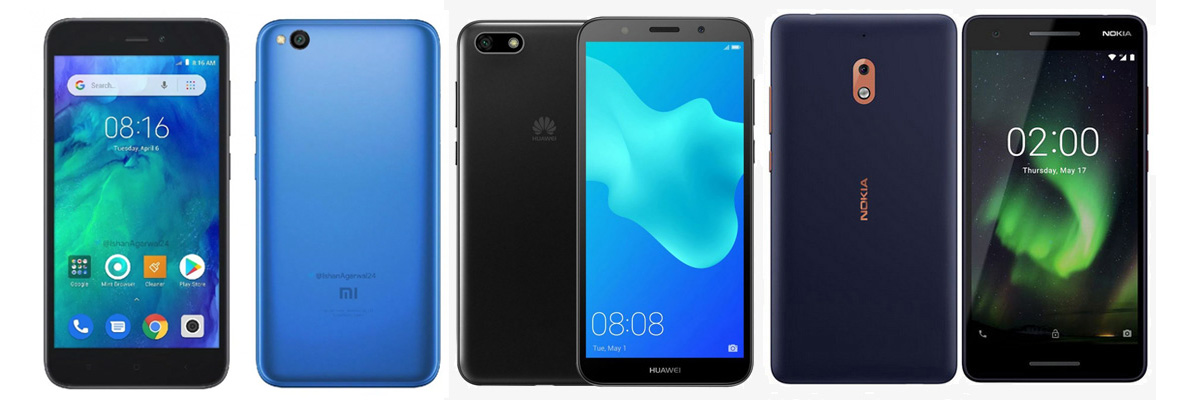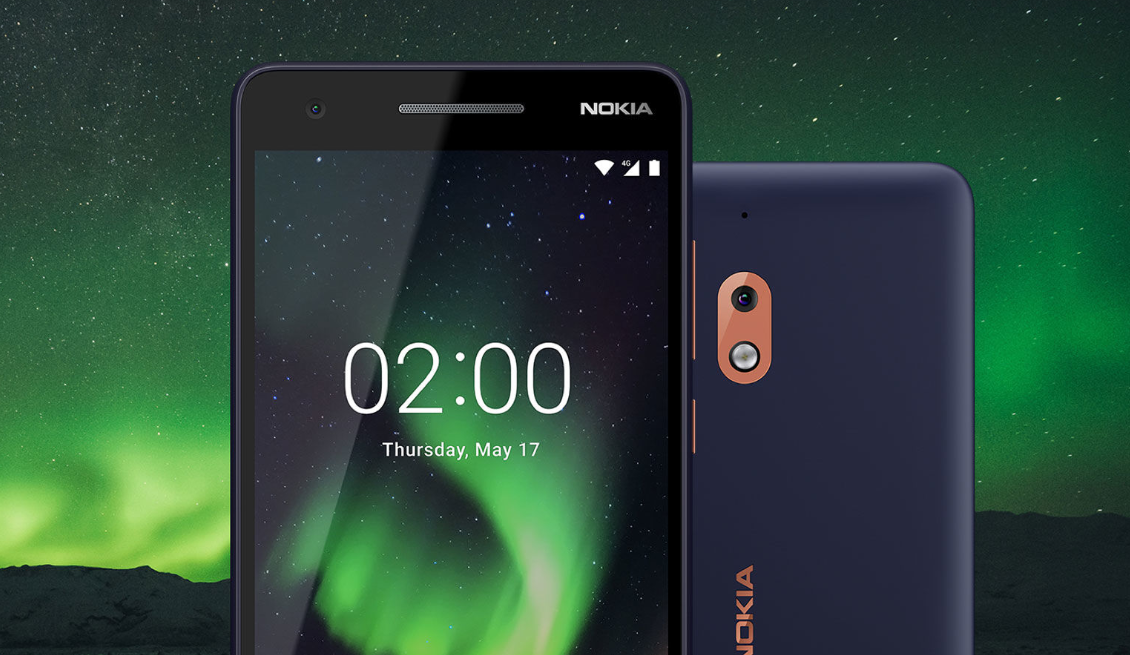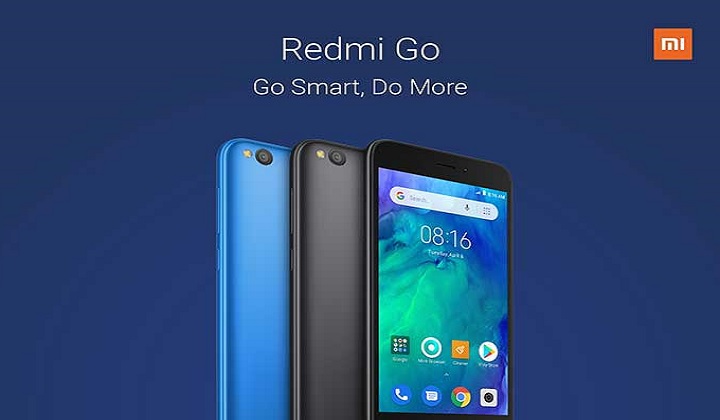The wisest choice to get the cheapest entry-level handset is opting for an Android Go device because Android Go is a lite version of the operating system suitable for devices with low-end or outdated components. Unlike the standard Android version, it can run smoothly even on smartphones with less than 1 GB of RAM. Finally even Xiaomi, that is one the most known manufacturer of budget phones, released an Android Go handset: the Redmi Go. Here, we compared it with the other best phones with this version of the operating system: the Nokia 2.1 and the Huawei Y5 Lite.

Xiaomi Redmi Go vs Nokia 2.1 vs Huawei Y5 Lite
| Xiaomi Redmi Go | Nokia 2.1 | Huawei Y5 Lite | |
|---|---|---|---|
| DIMENSIONS AND WEIGHT | 140.4 x 70.1 x 8.4 mm, 137 grams | 153.6 x 77.6 x 9.7 mm, 174 grams | 146.5 x 70.9 x 8.3 mm, 142 grams |
| DISPLAY | 5 inches, 720 x 1280 pixels, 294 ppi, 16:9 ratio, LCD | 5.5 inches, 720 x 1280p (HD), 267 ppi, 16:9 ratio, IPS LCD | 5.45 inches, 720 x 1440 pixels, 295 ppi, 18:9 ratio, LCD |
| PROCESSOR | Qualcomm Snapdragon 425, quad-core 1.4 GHz | Qualcomm Snapdragon 425, quad-core 1.4 GHz | Mediatek MT6739, quad-core 1.5 GHz |
| MEMORY | 1 GB RAM, 8 GB – micro SD dedicated slot | 1 GB RAM, 8 GB – micro SD dedicated slot | 1 GB RAM, 16 GB – micro SD dedicated slot |
| SOFTWARE | Android 8.1 Oreo, Android Go | Android 8.1 Oreo, Android Go | Android 8.1 Oreo, Android Go |
| CONNECTIVITY | Wi-Fi 802.11 b/g/n, Bluetooth 4.1, GPS | Wi-Fi 802.11 b/g/n, Bluetooth 4.2, GPS | Wi-Fi 802.11 b/g/n, Bluetooth 4.2, GPS |
| CAMERA | 8 MP f/2.0 5 MP f/2.2 front camera |
8 MP 5 MP front camera |
8 MP f/2.2 5 MP f/2.2 front camera |
| BATTERY | 3000 mAh | 4000 mAh | 3020 mAh |
| ADDITIONAL FEATURES | Dual SIM slot | Dual SIM slot | Dual SIM slot |
Design
Android Go devices always come with outdated hardware components and the same happens with the aesthetics. Xiaomi Redmi Go and Nokia 2.1 still come with 16:9 display that nowadays are rarely used in the smartphones market. So their bezels are all but narrow and the phones do not look so attractive. Huawei Y5 Lite has an 18:9 display, so it has a slightly better look thanks to its slimmer bezels and a taller design. But Nokia 2.1 has the best build quality thanks to its aluminum frame and the Gorilla Glass protection for the display. It is even the only Android Go phone to feature loud stereo speakers.
Display
Nokia 2.1 has the most interesting display because it is the biggest one, so also the most suitable for productivity. But you won’t get a better display quality than its opponents; more or less, these handsets feature the same level of detail and color reproduction. In my opinion, Nokia 2.1 a better device to watch videos and for productivity because of its bigger display paired with stereo speakers. Note that even though Huawei Y5 Lite has a 5.45-inch display (Nokia 2.1 is 5.5-inch), it has a way inferior display surface than Nokia 2.1 due to its taller aspect ratio.
Specs
Coming to specs, Xiaomi Redmi Go and Nokia 2.1 are the ones with the most reliable chipset: the Snapdragon 425 by Qualcomm that is an entry-level but it can provide very smooth performances even on the standard Android version. Huawei Y5 Lite has a worse SoC in my opinion, but it doubles the internal storage from 8 to 16 GB and this may be important for you if you usually record a lot of videos or install a lot of apps. Note that all of these devices have a micro SD dedicated slot, but installing apps on SD cards is not recommended as it slows down their performances. And this counts a lot on an entry-level device. So if you plan to install a lot of apps, then go for a higher amount of storage. The operating systems of all these handsets are based on Android 8.1 Oreo and we already know that Nokia 2.1 will get the update to the next major version Android Pie, despite being one of the most affordable devices from Nokia.
Camera
The cameras of all these handsets are mediocre, but Xiaomi Redmi Go seems to have a slightly better sensor on the back, at least on the paper. It features an 8 MP snapper with an f/2.0 aperture which is bright enough for sufficient photos when light conditions are not so bad. If selfies are your main concern, then Huawei Y5 Lite is a definitely better handset because it offers a front-facing LED flash allowing to shoot selfies even in the dark. Nokia 2.1 is the most disappointing one, it does not even come with Carl Zeiss lenses unlike most of the devices from HMD Global’s line-up.
Battery
With Xiaomi Redmi Go and Huawei Y5 Lite offering just 3000 mAh of battery capacity, Nokia 2.1 is the handset with the longest battery life. It has a huge 4000 mAh battery which powers very efficient components. With an HD display and an efficient Snapdragon 425 chipset, this handset can last more than two days even if you stress it, on a single charge. However, just like its rivals, it does not feature a fast charging technology, so it will take a while to fully charge it. But once you charged it completely, you can forget the charger.
Price
Xiaomi Redmi Go vs Nokia 2.1 vs Huawei Y5 Lite: PROs and CONS
Xiaomi Redmi Go
PROs
- Compact design
- Affordable price
- Good cameras
- Micro SD dedicated slot
CONS
- Bezels and small display
Nokia 2.1
PROs
- Big display
- Biggest battery
- Affordable
- Stereo speakers
- Micro SD dedicated slot
CONS
- Bezels
Huawei Y5 Lite
PROs
- Compact dimensions
- Micro SD dedicated slot
- Front-facing LED flash
- Affordable
CONS
- Low-end hardware


![Buy Global Versions Of Xiaomi Mi Mix 3 And Redmi Go Smartphones At Reduced Prices On GeekBuying [Coupons]](https://www.gizmochina.com/wp-content/uploads/2019/03/GeekBuying-Hot-Sellers-Mega-Sale.jpg)



